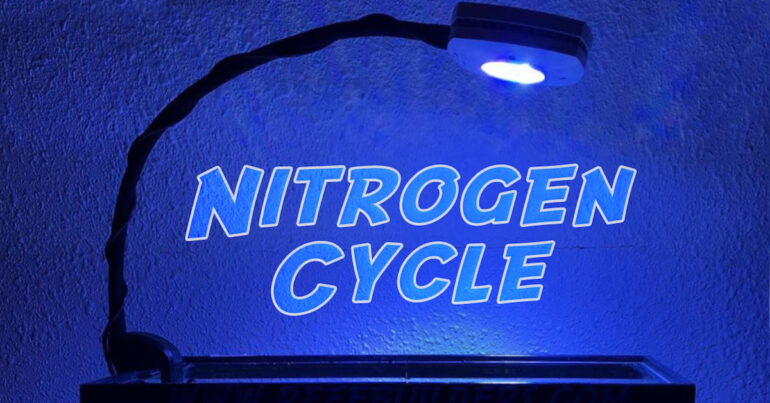Nitrogen Cycle For Saltwater Aquariums
No we don’t mean strapping your tank to a bike and taking it for a spin! Cycling your saltwater aquarium is a critical process all aquariums must endure before they are ready to be populated with fish and corals.
So what is cycling you ask? The term refers to the Nitrogen cycle, a process where beneficial bacteria start building up in your aquarium breaking down harmful ammonia (NH3), into nitrite (NO2) and then nitrate (NO3).
When you first set up a brand spanking new aquarium, your aquarium tank and equipment will be squeaky clean. Be prepared to say goodbye to this new aquarium smell, because things are about to dirty, but trust us, dirty is a good thing at this point.
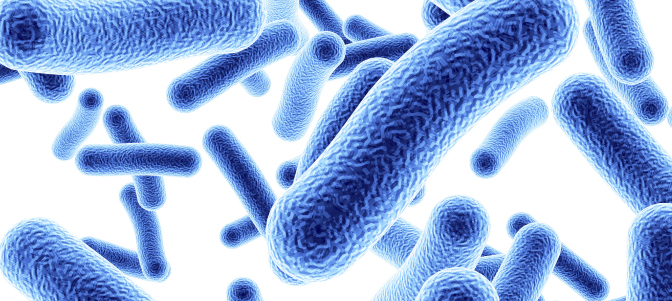
Cycling your aquarium can take anywhere from 2-6 weeks, depending on your setup, and how proactive you are in helping the process along the way. Patience is a virtue in the aquarium hobby, and if you’re already groaning at the possibility of an empty glass box in your living room for a month, well, you might want to reconsider your decision to get an aquarium, because, in this hobby, good things come to those who wait.
Get Started With Live Rock
To start the cycling process you need to seed your tank with rocks, or filter medium that already contain a mature bacteria population. The best way to do this is with a big ol’ piece of live rock, or a bag of ceramic filter medium that’s been hanging out in a mature tank for at least six months. You can get live rock from your local fish store, or from a friend with an established tank, just keep your eyes out for any pests or excessive algae growing on the rock.
Examine the undisturbed rock in the water for any pests before transferring it to your tank. You can use a soft bristle brush to scrub off any algae, but be careful there are no zoanthids or palythoa polyps hiding on the rock. Scrubbing a rock with these polyps can be deadly to your health.

Once your tank is up an running and you’ve added some mature liverock, the bacteria on this rock will need a source of ammonia, so they can start doing their job, and colonize your tank. Fish waste, and decaying organic mater like fish food, is a common source of ammonia, although it is not recommended to start adding fish before your cycle is complete. Fish can quickly produce more ammonia than your new tank can handle, and a sudden ammonia spike can spell disaster for your animals.
Instead let your tank run with a live rock for a week or more and then add in a couple invertebrates, like hermit crabs, crabs, and shrimp. This bunch of critters is also called the clean up crew. Feed your invertebrates a very small pinch of food each day and the waste they produce will create ammonia.
Test Test Test
During the cycle process, you want to start testing your aquarium almost every day for ammonia, nitrites and nitrates. This will help you understand if the cycle is underway and when it is safe to start adding livestock.
After a week or ten days, you should see a spike in ammonia concentration, jumping from zero to a higher number. This is followed by a spike in nitrite, follow by a spike in nitrate. After your nitrate goes up, your nitrite and ammonia level should fall back down to zero. Once you have observed this change in water chemistry your Nitrogen cycle is complete.
What Going On
The cycle starts with ammonia, but the goal is to establish a colony of nitrobacter bacteria which process nitrite into less harmful nitrate.
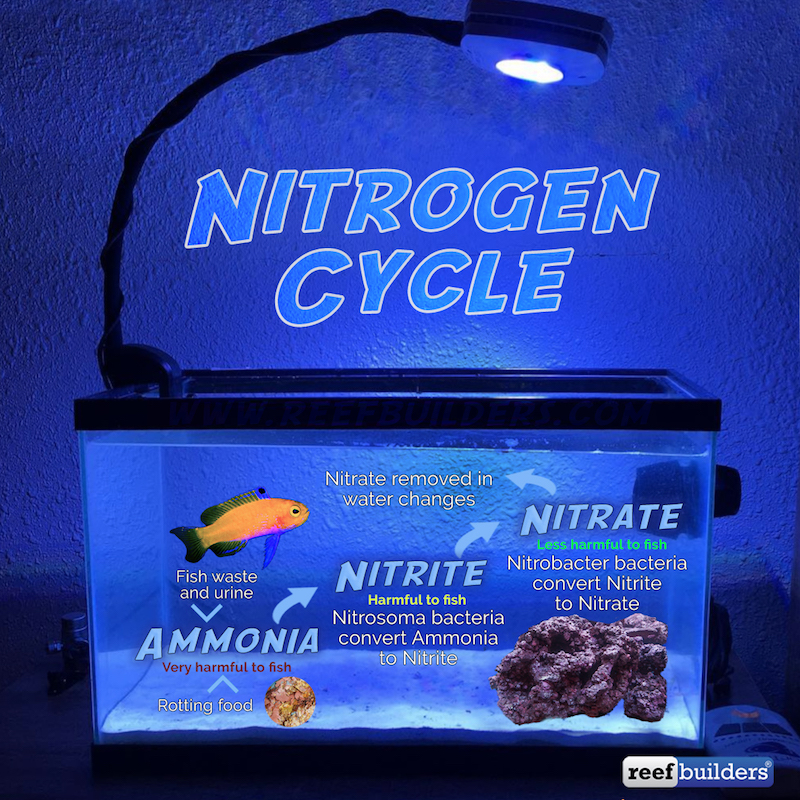 How it works is nitrosoma bacteria start converting ammonia, to nitrite. Then nitrobacter bacteria being consuming the harmful nitrite into less harmful nitrate.
How it works is nitrosoma bacteria start converting ammonia, to nitrite. Then nitrobacter bacteria being consuming the harmful nitrite into less harmful nitrate.
Nitrate levels should be in trace amounts in the aquarium, and a safe range for a reef tank is below 5ppm. If you have a fish only reef tank you can have your levels higher up to 40ppm, however, it is always recommended to have level lower than 5ppm. That being said, certain soft corals and especially giant clams appreciate a little extra nitrate in the water, and there are plenty of successful reef tanks, even SPS dominated, which succeed in water with nitrate concentrations upwards of 50ppm.
Once nitrobacter are growing they need oxygen and food to survive and thrive this is why they are called ‘aerobic’ bacteria and grow especially well in wet-dry filters. The nitrobacter will start growing on all the surfaces of your tank including the walls and rocks. When you are testing your water and start to see nitrate level creeping up you know nitrobacter is getting things done.
During the cycling process, you need to go through all three steps, ammonia spike, nitrite spike, and nitrate accumulation. If for some reason you decide to clean your tank or do a water change after seeing a spike in ammonia, you’re going straight back to square one and will have to start the process all other again.
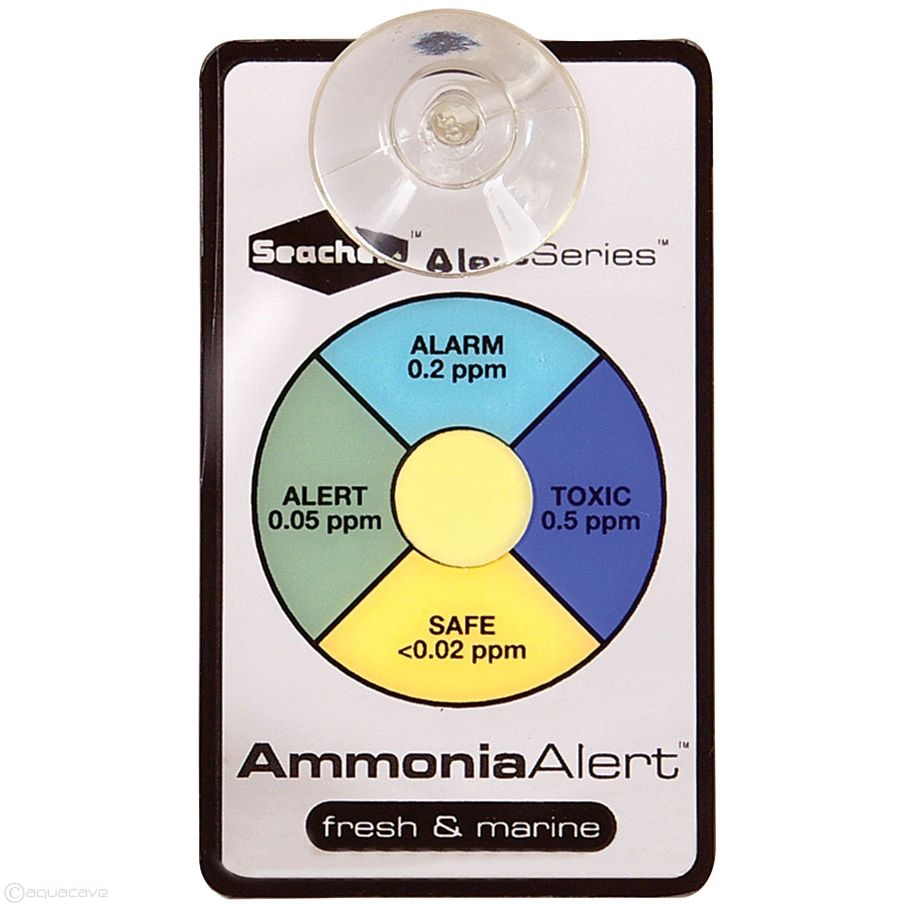
To monitor your ammonia level, you can purchase ammonia alert tags by Seachem which stick to the inside of your aquarium glass. This will give you a quick and easy way to monitor ammonia levels.
The older your tank gets the more nitrobracter bacteria are maturing, reproducing and colonizing your aquarium, esentially speeding up the cycling process. However, just because you’ve completed the cycle dosn’t mean these processes arn’t still continuing. Every time you add a new fish, or have food left over to rot in the tank ammonia levels start to rise.
Once your cycle in complete, and you see nitrate levels rise, and ammonia and nitrate level fall, you are safe to add your first fishy friend. But, remember what I said in the beginning about patience… You always want to take things slow, adding fish one at a time and letting your tank adjust.
Start Your Tank Off Right – BioDigest
Now that we’ve driven home the point of taking things easy, slow and steady, we want to let you in on a little secret. The nitrogen cycle is a necessary step for starting all saltwater aquariums, and aquarium manufacturers want to make this process as quick and painless as possible.
There are a few products on the market which help kick-start your biological cycle with a dose of nitrifying bacteria. One of our favorites is BioDigest by Prodibio, which are vials of lab-grown bacteria to start of your biological cycle.
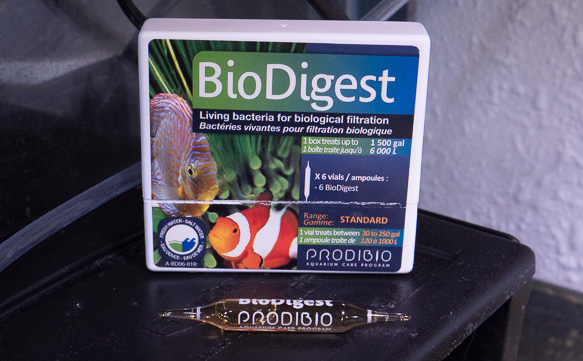
BioDigest is a concentrated bacteria for all steps of the process. Each vial lasts about 15 days in the aquarium and if you are looking to speed up the process you can add a new vial every 15 days, instead of trying to increase the dose with two vials from the get go.
A Dose Of Nitrifying Bacteria
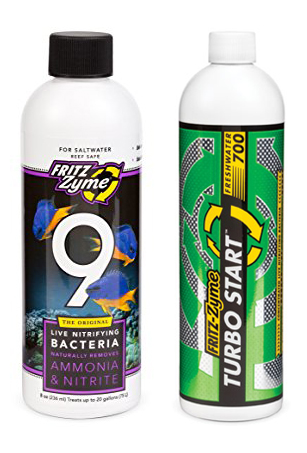 Another product to start you bacteria cycle is FritzZyme 9 which contain a balance of live nitrifying bacteria to seed your tank. This product can be added to new tanks or for a boost of bacteria to established systems, especially after large water changes.
Another product to start you bacteria cycle is FritzZyme 9 which contain a balance of live nitrifying bacteria to seed your tank. This product can be added to new tanks or for a boost of bacteria to established systems, especially after large water changes.
And if you really need to get a tank going in a hurry, Fritz also offers a FritzZyme TurboStart 900. This could come in handy if you are setting up a quarantine tank, or for frag, vendors setting up tanks for the weekend.
Get Cycling
Whatever method you use for cycling you aquarium the important part is to understand why you cycle in the first place. Cycling you tank ensures good bacteria builds up, and is able to consume ammonia before it gets out of hand.
Both ammonia and nitrite can be deadly to fish, even if small doses, so it’s essential to control, even nitrate can be a problem if left unattended. If you’re just starting out we recommend the slow and steady method. This gives you time to learn how to test and track your water quality, and make sure your tank is running smoothly before you go adding livestock.
If you have questions about cycling your new aquarium, leave them in the comment below.


